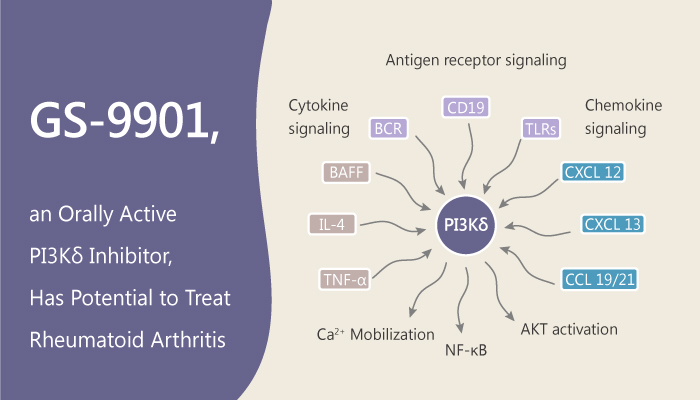Phosphoinositide 3-kinase (PI3K) plays an indispensable role in the signal transduction of numerous cellular functions via the formation of the second messenger PIP3. In previous blogs, I have introduced a few PI3K targeted compounds, including LAS191954, BGT226 and SAR-260301. A recent study from Leena Patel discovered and identified another orally active PI3Kδ Inhibitor, GS-9901 (compound 35).

GS-9901 (compound 35) displayed high PI3Kδ potency, isoform selectivity, and chemical stability at low pH. In addition, when dosed in vivo, GS-9901 (compound 35) displayed excellent correlation, good oral availability in rat. And it exhibited a higher volume of distribution in the dog.
Mechanically, GS-9901 (compound 35) bound to the ATP binding site of the kinase domain of PI3Kδ. The substituted pyrimidine of GS-9901 (compound 35) served as the hinge binder and forms a three-point interaction to Val828 and Glu826. Besides, GS-9901 (compound 35) induced a conformational change at the ATP binding site.
In vitro experiments also revealed that GS-9901 (compound 35) was potent against all four class I PI3K isoforms, PI3Kα, PI3Kβ, PI3Kγ, and PI3Kδ.
Additionally, in vivo, the authors used Female Lewis rats with established collagen-induced arthritis to test the function of GS-9901 (compound 35) in animals. CIA models were dosed orally with 35 at 0.3/1/3 mg/kg twice-daily for 7 days. Treatment started on the 10 th day after the second collagen immunization. As a result, GS-9901 (compound 35) demonstrated significant reduction in ankle swelling. No obvious toxicity was found.
Moreover, other tests were consistent with the above. Therefore, these data suggest that GS-9901 is a highly selective and orally active PI3Kδ inhibitor, with an IC50 of 1 nM. GS-9901 has potential to treat rheumatoid arthritis.